 When a lot of designers and creative types think about photo editing, they think Photoshop. But the truth is that Photoshop can be way over-powered for many types of photo editing. And all those options can lead to creative overload, making it impossible to get your work done in a timely manner.
That doesn't mean you don't need a program that's incredibly powerful, though. Adobe Photoshop Lightroom 4 is just that: a photo editing program that's fantastic at photo editing and retouching, without adding in a bunch of functionality that's more suited to design than photo editing.
Lightroom 4 adds some great functionality that was missing from previous versions. Below we've covered some of the best new features, which should help you decide whether Lightroom 4 is right for you (hint: if you edit photos more than just occasionally, it probably is!).
When a lot of designers and creative types think about photo editing, they think Photoshop. But the truth is that Photoshop can be way over-powered for many types of photo editing. And all those options can lead to creative overload, making it impossible to get your work done in a timely manner.
That doesn't mean you don't need a program that's incredibly powerful, though. Adobe Photoshop Lightroom 4 is just that: a photo editing program that's fantastic at photo editing and retouching, without adding in a bunch of functionality that's more suited to design than photo editing.
Lightroom 4 adds some great functionality that was missing from previous versions. Below we've covered some of the best new features, which should help you decide whether Lightroom 4 is right for you (hint: if you edit photos more than just occasionally, it probably is!).
Module-based workflow
Lightroom 4 includes seven workspace modules for specific portions of your photographic workflow. Use the Library module for managing and organizing the photos in your catalog. The Develop module lets you adjust the color and tonal scale of your photos. Any edits you make in Lightroom are nondestructive, so you can always roll back to your original image if necessary.
The Map module lets you organize your photos based on where they were taken. This is an awesome feature for travel photographers, or anyone who wants to plot their photographic journey.
The Develop module lets you adjust the color and tonal scale of your photos. Any edits you make in Lightroom are nondestructive, so you can always roll back to your original image if necessary.
The Map module lets you organize your photos based on where they were taken. This is an awesome feature for travel photographers, or anyone who wants to plot their photographic journey.
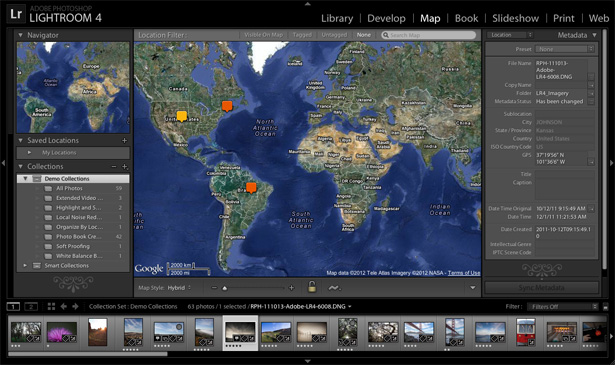 Lightroom 4 includes a Book module for creating photo books you can then export to PDF or send directly to Blurb for printing. Slideshows can be created easily, too, complete with music and transitions on the Slideshow module.
Lightroom 4 includes a Book module for creating photo books you can then export to PDF or send directly to Blurb for printing. Slideshows can be created easily, too, complete with music and transitions on the Slideshow module.
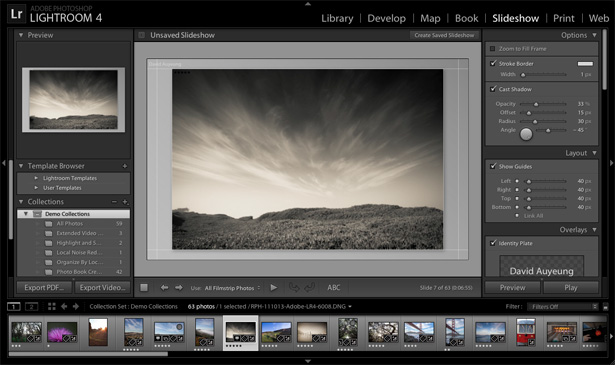 The Print module makes it easy to specify page layouts for printing your photos and contact sheets.
The Print module makes it easy to specify page layouts for printing your photos and contact sheets.
 The Web module gives you options for publishing your pictures to the web. You can create website photo galleries right in Lightroom, making it a fantastic option for photographers who want to manage their own websites without learning a new program.
The Web module gives you options for publishing your pictures to the web. You can create website photo galleries right in Lightroom, making it a fantastic option for photographers who want to manage their own websites without learning a new program.
Video support
Considering that virtually every camera out there (not to mention most cell phones) now has a video mode, it only makes sense that your photo editing software can also perform basic edits on your videos. Lightroom 4 has built-in tools for video editing, including the ability to apply some of the basic preset filters and organizing your video clips right alongside your photos. Video editing options include making adjustments and edits, playing and trimming clips, and extracting still images from your clips. Because the adjustments for videos are the same as those for still photos, it's easy to make stills and video match up. Lightroom 4 also makes it easy to publish your videos in HD format. You can publish directly to Facebook and Flickr, as well as export them to formats compatible with your favorite video sharing sites.Advanced photo editing
One of the most powerful features of Lightroom 4 is highlight and shadow recovery. It can pull every detail out of the darkest and lightest parts of your images, details you didn't even know were there!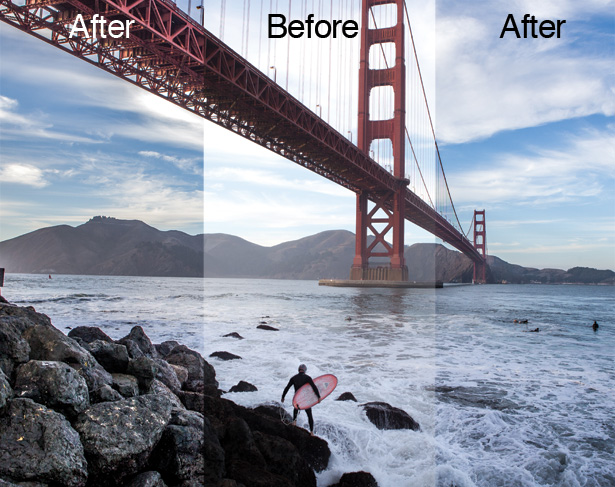 You get four adjustment sliders for adjusting the tone of the image: Highlights, Shadows, Whites, and Blacks. You also get sliders for Exposure and Contrast. And on top of that, there's an Auto option that can work wonders on your images with just a single click.
You get four adjustment sliders for adjusting the tone of the image: Highlights, Shadows, Whites, and Blacks. You also get sliders for Exposure and Contrast. And on top of that, there's an Auto option that can work wonders on your images with just a single click.
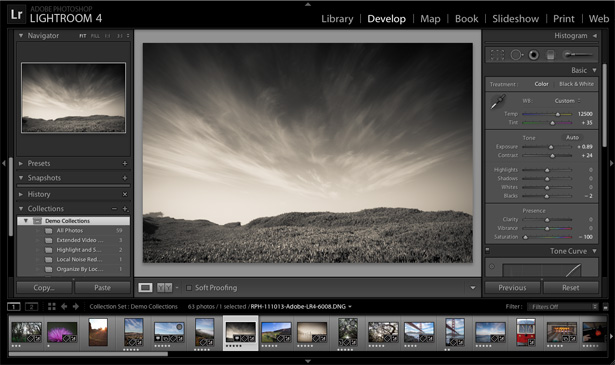 There are also new adjustment brushes for making precise adjustments to targeted areas. You can reduce noise and moire, adjust the white balance, and get more control over local adjustments. These precise controls make it easier to get exactly the look you want.
There are also new adjustment brushes for making precise adjustments to targeted areas. You can reduce noise and moire, adjust the white balance, and get more control over local adjustments. These precise controls make it easier to get exactly the look you want.
Print and web publishing options
This is one of the biggest differences between Lightroom and programs like Photoshop. Lightroom offers a number of tools to help you publish your photos, either in print or to the web. The Book module lets you easily create a photo book that you can then have printed (or publish as a PDF). There are both auto layout and manual options for creating your books.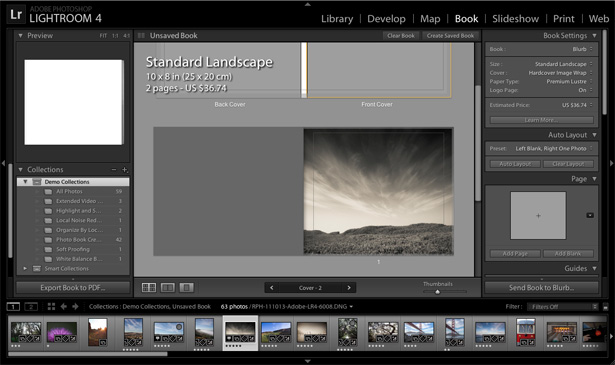 You can easily publish to Facebook and Flickr, directly from Lightroom. You can easily add images to specific albums on Facebook, just by dragging and dropping them on the album name. The best part is that you can view and add comments to your images right from inside Lightroom!
Creating slideshows is easy, too. From within the Slideshow module, you can add borders and backgrounds, title screens, and even a soundtrack. When you're done creating your slideshow, click on Export Video and you'll get a video that can be shared outside of Lightroom. There are even templates to make it quicker and easier to create your slideshows.
If you need to publish a full website with your photos, you can easily create that right in Lightroom, too. Just go to the Web module and choose your gallery layout and design, and then customize. It's as simple and intuitive as every other aspect of Lightroom.
You can easily publish to Facebook and Flickr, directly from Lightroom. You can easily add images to specific albums on Facebook, just by dragging and dropping them on the album name. The best part is that you can view and add comments to your images right from inside Lightroom!
Creating slideshows is easy, too. From within the Slideshow module, you can add borders and backgrounds, title screens, and even a soundtrack. When you're done creating your slideshow, click on Export Video and you'll get a video that can be shared outside of Lightroom. There are even templates to make it quicker and easier to create your slideshows.
If you need to publish a full website with your photos, you can easily create that right in Lightroom, too. Just go to the Web module and choose your gallery layout and design, and then customize. It's as simple and intuitive as every other aspect of Lightroom.
 Lightroom 4 is a fantastic program for any photographer out there, whether you're an amateur or a pro. The ability to draw out details and make adjustments quickly and easily is invaluable, whether you take photos with a five thousand dollar DSLR or your smartphone. In fact, Lightroom can make your smartphone photos look a lot more like DSLR pics than you might have thought possible!
Lightroom 4 is a fantastic program for any photographer out there, whether you're an amateur or a pro. The ability to draw out details and make adjustments quickly and easily is invaluable, whether you take photos with a five thousand dollar DSLR or your smartphone. In fact, Lightroom can make your smartphone photos look a lot more like DSLR pics than you might have thought possible!
Read Next
15 Best New Fonts, July 2024
Welcome to our monthly roundup of the best fonts we’ve found online in the last four weeks. This month, there are fewer…
By Ben Moss
20 Best New Websites, July 2024
Welcome to July’s round up of websites to inspire you. This month’s collection ranges from the most stripped-back…
Top 7 WordPress Plugins for 2024: Enhance Your Site's Performance
WordPress is a hands-down favorite of website designers and developers. Renowned for its flexibility and ease of use,…
By WDD Staff
Exciting New Tools for Designers, July 2024
Welcome to this July’s collection of tools, gathered from around the web over the past month. We hope you’ll find…
3 Essential Design Trends, July 2024
Add some summer sizzle to your design projects with trendy website elements. Learn what's trending and how to use these…
15 Best New Fonts, June 2024
Welcome to our roundup of the best new fonts we’ve found online in the last month. This month, there are notably fewer…
By Ben Moss
20 Best New Websites, June 2024
Arranging content in an easily accessible way is the backbone of any user-friendly website. A good website will present…
Exciting New Tools for Designers, June 2024
In this month’s roundup of the best tools for web designers and developers, we’ll explore a range of new and noteworthy…
3 Essential Design Trends, June 2024
Summer is off to a fun start with some highly dramatic website design trends showing up in projects. Let's dive in!
15 Best New Fonts, May 2024
In this month’s edition, there are lots of historically-inspired typefaces, more of the growing trend for French…
By Ben Moss
How to Reduce The Carbon Footprint of Your Website
On average, a web page produces 4.61 grams of CO2 for every page view; for whole sites, that amounts to hundreds of KG…
By Simon Sterne
20 Best New Websites, May 2024
Welcome to May’s compilation of the best sites on the web. This month we’re focused on color for younger humans,…














